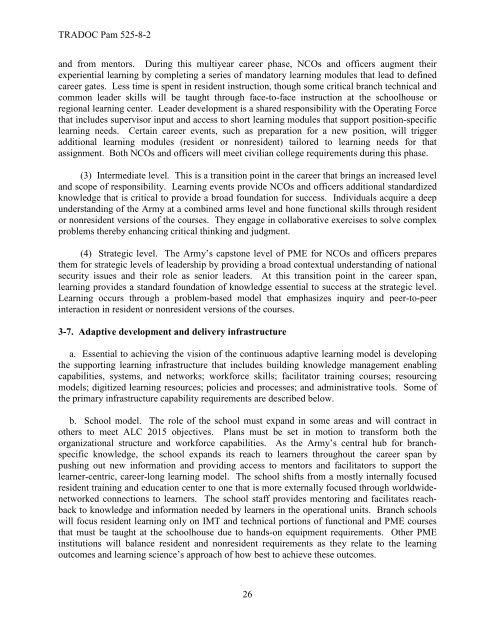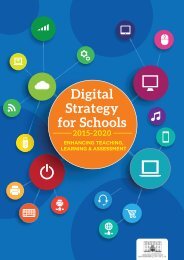K3zgZ
K3zgZ
K3zgZ
Create successful ePaper yourself
Turn your PDF publications into a flip-book with our unique Google optimized e-Paper software.
TRADOC Pam 525-8-2<br />
and from mentors. During this multiyear career phase, NCOs and officers augment their<br />
experiential learning by completing a series of mandatory learning modules that lead to defined<br />
career gates. Less time is spent in resident instruction, though some critical branch technical and<br />
common leader skills will be taught through face-to-face instruction at the schoolhouse or<br />
regional learning center. Leader development is a shared responsibility with the Operating Force<br />
that includes supervisor input and access to short learning modules that support position-specific<br />
learning needs. Certain career events, such as preparation for a new position, will trigger<br />
additional learning modules (resident or nonresident) tailored to learning needs for that<br />
assignment. Both NCOs and officers will meet civilian college requirements during this phase.<br />
(3) Intermediate level. This is a transition point in the career that brings an increased level<br />
and scope of responsibility. Learning events provide NCOs and officers additional standardized<br />
knowledge that is critical to provide a broad foundation for success. Individuals acquire a deep<br />
understanding of the Army at a combined arms level and hone functional skills through resident<br />
or nonresident versions of the courses. They engage in collaborative exercises to solve complex<br />
problems thereby enhancing critical thinking and judgment.<br />
(4) Strategic level. The Army’s capstone level of PME for NCOs and officers prepares<br />
them for strategic levels of leadership by providing a broad contextual understanding of national<br />
security issues and their role as senior leaders. At this transition point in the career span,<br />
learning provides a standard foundation of knowledge essential to success at the strategic level.<br />
Learning occurs through a problem-based model that emphasizes inquiry and peer-to-peer<br />
interaction in resident or nonresident versions of the courses.<br />
3-7. Adaptive development and delivery infrastructure<br />
a. Essential to achieving the vision of the continuous adaptive learning model is developing<br />
the supporting learning infrastructure that includes building knowledge management enabling<br />
capabilities, systems, and networks; workforce skills; facilitator training courses; resourcing<br />
models; digitized learning resources; policies and processes; and administrative tools. Some of<br />
the primary infrastructure capability requirements are described below.<br />
b. School model. The role of the school must expand in some areas and will contract in<br />
others to meet ALC 2015 objectives. Plans must be set in motion to transform both the<br />
organizational structure and workforce capabilities. As the Army’s central hub for branchspecific<br />
knowledge, the school expands its reach to learners throughout the career span by<br />
pushing out new information and providing access to mentors and facilitators to support the<br />
learner-centric, career-long learning model. The school shifts from a mostly internally focused<br />
resident training and education center to one that is more externally focused through worldwidenetworked<br />
connections to learners. The school staff provides mentoring and facilitates reachback<br />
to knowledge and information needed by learners in the operational units. Branch schools<br />
will focus resident learning only on IMT and technical portions of functional and PME courses<br />
that must be taught at the schoolhouse due to hands-on equipment requirements. Other PME<br />
institutions will balance resident and nonresident requirements as they relate to the learning<br />
outcomes and learning science’s approach of how best to achieve these outcomes.<br />
26




